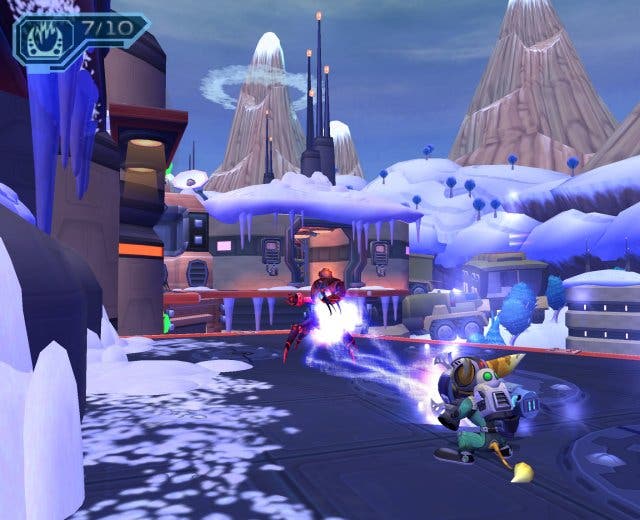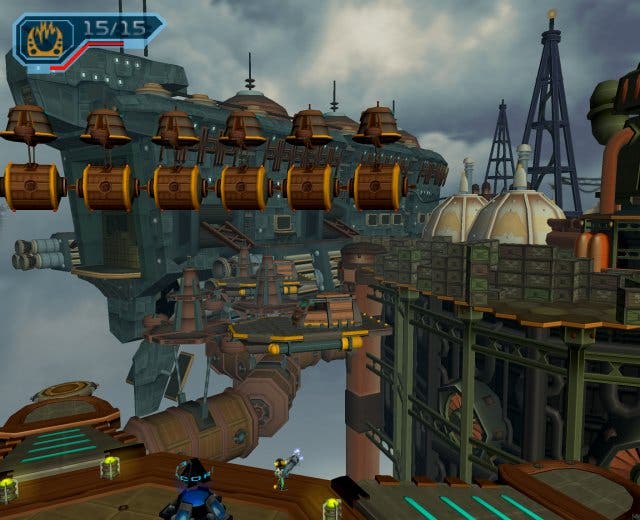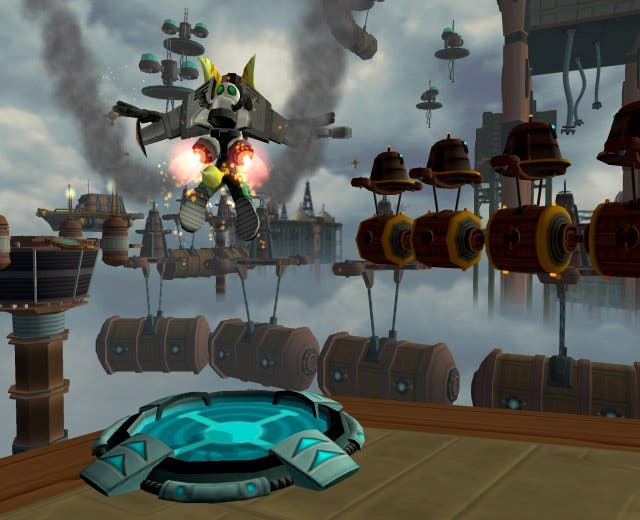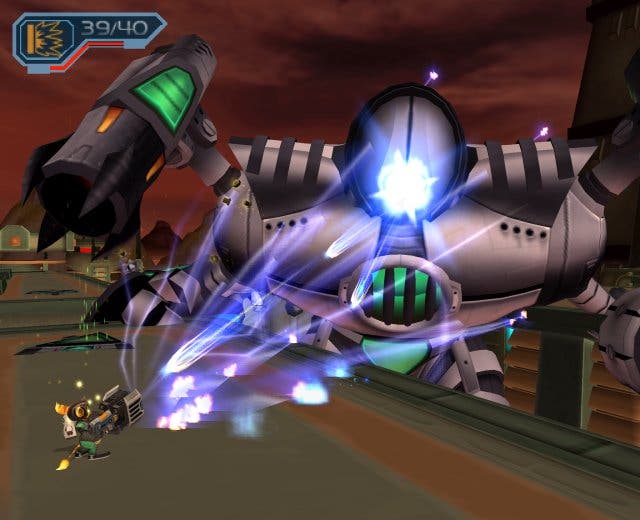Ratchet & Clank 2: Locked & Loaded
Tom loads up for the PS2's next big platformer.
Given that Ratchet & Clank was rather unflatteringly held up as Jak & Daxter with guns, it hardly seemed fair when Naughty Dog's Jak II: Renegade borrowed a futuristic location and flying cars, and mixed heavy weaponry and traditional platforming to great effect. Doubly so when you consider the quantum leaps it made over its predecessor's narrative, structure and sense of humour.
Compared to Jak II (which is sadly inevitable), Ratchet & Clank 2 is a much more straightforward sequel. There's no massive deviation from the previous game here - just smaller, subtler changes and a new and larger selection of planets to consider. But although Insomniac Games refrained from throwing the whole thing out the window and starting again with a blank canvas, their platformer grows to reveal itself as a far more thoughtfully resurrected package, and shows us that while Naughty Dog had to build an entirely new premise to stage their game, there's still a great deal of life left in the R&C universe.
The True Renegade

Despite the similarly sci-fi setting, R&C2 doesn't share a great deal in common with Jak II. While the latter focused on plot and platforms and kept a rigid set of rules in place throughout (scant few meaningful upgrades, four health points, etc), progress through R&C2's platform environments is much more RPG-like, with regular health, tool, weapon and ship upgrades, and a system that doesn't demand backtracking, thorough exploration and repeated play, but at the same time is quite happy to reward it.
However with fond memories of Jak II still swimming around in my head (and wounds still throbbing on my hands), taking in the first level of Ratchet & Clank 2 was like going back in time. The game's characteristic humour was there from the very first cut-scene, the style and pacing of the levels (with a primary route and a secondary route for each), not to mention the range of objectives and gameplay styles (straight platforming, third-person shooter, etc) were consistent with the first game, and Ratchet's abilities (and even his guns) were largely familiar. Although it was comforting to slip back into it so easily, it was also vaguely underwhelming - as though Jak II's very existence had somehow dated it.
But although Insomniac lessened R&C2's impact with its "if it ain't broke" approach, the new locations, new characters, new weapons and particularly the new experience/upgrades system make a huge difference to the end product. The most transparent changes make up Ratchet's arsenal of weapons and tools, hugely improved over the first game - so much so that the old weapons you quickly inherit seem almost timid and wimpy by comparison. The Gravity Bomb, which functions a lot like the first game's Bomb Glove, is a splendid addition, while the Lava Gun, with leaves a little lava trail as you run, jump and spin around, is almost like a shield of flames as well as a sort of magma hose.
When old becomes new

Then there's the fact that each weapon is quickly upgraded to a deluxe 'Gold' version with repeated use. As you'll see on the inventory screen, weapons each get their own little progress gage, and with enough use this little bar fills up and said weapon throbs merrily into an improved alternative. Gravity Bombs, indispensable and hugely enjoyable to use, quickly become Mini-Nukes, mushroom-cloud-laying grenade-like objects which decimate the ranks of even the toughest adversaries. Some upgrade paths aren't quite so satisfying - the Lava Gun loses its seeping trail of magma, to stick with that example - but, more so than before, R&C2 is about getting the most out of what you have, and having to adjust the way you're playing the game to take advantage of what is actually a more powerful projectile weapon is well worth the hassle. Even when you get stuck midway through a level and have to plumb the depths of your inventory to make it to the other side, it's still rewarding - and actually rewarding in a different way.
Still, some will complain that many of R&C2's weapons, just as with the original game, feel secondary and quickly find themselves relegated to last-ditch and contrived application - yanked out only when the player is stuck on a section and the last ammo dispensary is out of reach - but although it's true to some extent that you'll settle on a core selection of weapons for regular usage, you'll still find yourself buzzing to try out your latest find even late on in the game, and it seems highly likely that certain players will find certain combinations better suited to their style of play than others - with this in mind, the diversity is more than welcome. Personally, I made it through the game relying almost entirely on heavy weapons (Rockets, Nukes, etc), but a friend of mine reviewing it for a magazine in the States tells me he got through it relying far more heavily on the hands-off stuff, like the Spider Glove, Chopper (think Unreal's disc launcher weapon) and Synthoid bodyguards.
That's not all for weapon upgrade paths, either. By collecting some of the game's many Platinum Bolts - dotted around levels in obscure and seemingly unreachable areas - Ratchet can invest in modifiers like better strafing, poison-tipped ammo and increased splash damage.
Ratcheted up

Upgrades also make their way into many other aspects of the game, like Ratchet's health and basic abilities. The addition of something called Nanotech means Ratchet regularly gains another cluster of four hitpoints, up to a total of 80, through repeated play. Again, progress between upgrades is clearly noted on a narrow progress bar beneath his health stats, so the player will often find himself scrambling through a horde of enemies, trying to gather that last slither of experience to tip the gage over and reap the rewards - a higher hitpoint capacity and a refilled health bar.
Ratchet & Clank 2 is also a much harder game, despite Ratchet's soon towering abilities, health stats and the increased strength he commands through the occasional new wrench. The difficulty level soon ramps up, with tougher, better-equipped enemies and more of them to overcome, not to mention more diverse and challenging levels. But, ingeniously, replaying a section over and over is never as pointless and deflating as it was in Jak II - or any of a million other similar titles - because the RPG-like system of progression means every subsequent attempt is oiling the rails for you and improving your stats. A good example is a section late on when Ratchet & Clank are trying to break an unlikely ally out of a big robot arms factory, and the player is faced with wave after wave of tanks, laser-spewing enemies and even flying gunships. Faced with this for the first time, I got absolutely hammered - repeatedly.
In any other game, I might have lost faith, but knowing R&C2 quite well I decided to do two things: upgrade my armour and keep trying. Upgrading my armour was the less obviously crucial of the two - R&C2's irregular armour upgrades cost hundreds of thousands of bolts (the game's returning currency), but they can be critically important to lessening the impact of enemy projectiles, something this level was raining down on me like never before. Returning to an earlier desert planet, I took a local lunatic up on his challenge to rid the desert of countless massive enemies and collect a series of crystals. Having accumulated literally thousands of bolts in a short space of time - from shattered carcases and this unscrupulous crystal-lover's wallet - I returned to the later planet, bought some new armour and set about bashing my way through the level.
Die, die, die

Again and again I failed, but after a number of retries my hitpoints rose a couple of notches, I got to know how certain enemies behaved, how many rockets it took to flatten the bigger ones, I realised that crushed tanks make decent cover to duck out from behind, and even though I was still laboriously smashing my way through the same section, it was the bits I hadn't done that posed the problem - because the game's design more than my own knowledge of them meant the earlier sections grew easier with repeated play. Eventually I knocked my way through, rewarded with a totally different kind of satisfaction to that I felt when I finally made it past the legions of Crimson Guards and escaped the water slums in one particularly foul episode of Jak II.
On the other hand, you might argue that R&C2 gets too hard towards the end, with a few levels that feel almost incongruous. Though I was glad to see the back of the abovementioned level, by resorting to brute force to slow me down and tap my reserves, the game was testing both my abilities and my patience rather more than it had to. Ok it's hardly much fun just gliding through every level with a yawn, either, but although commendable on some levels, the latter stages of R&C2 could perhaps have been done differently to better effect.
But then perhaps they were thrown into a dimmer light because the range of levels and objectives beforehand were so diverse and captivating. Although we're still functioning on the basis that each planet or level in the Ratchet & Clank universe consists of one main path to walk and one or two other, secondary paths, the activities are rarely if ever mundane, and the pay-off is always something of which you can make practical use, and not just another gemstone or plot device. Even after ten hours the game still manages to surprise you with new activities, and the range of things Ratchet & Clank have to do is immense.
Brains & Braun

Even now you may be thinking R&C2 is little more than a basic 3D platformer with guns - albeit upgradeable ones - but it also has a variety of interesting and original puzzles, like a series of rising and falling shark-infested pools, tunnels and a freeze/thaw gun to try carve a path with, hands-on devices like the electronic lockpick which require speed and precision in a cute little mini-game to use effectively, and more traditional power-ups like a glider - which takes you through memorable canyon and machine core levels - and Clank's mech-suit. The latter also introduces us to the recurring spherical 'moon' levels, which are often viewed like an ant crawling round a tennis ball, and genuinely offer something new - with the regularly made War of the Monsters comparison extremely fitting.
Sticking with Clank, fans of the first game can expect to control Ratchet's robotic, Daxter-like sidekick once more as he manipulates little service robots to open doors, build bridges, hammer through obstacles and attack enemies Clank can't destroy - it's actually not unlike Pikmin in some ways, and offers a welcome change of pace and approach to the more prevalent run-and-jump levels Ratchet has to contend with.
Also returning from R&C are an array of different boots and tools - allowing Ratchet to walk up the sides of buildings on certain metal surfaces (with enemies popping out of windows to take shots at you, and falling satisfyingly vast distances if you can hit them with anything), grind rails (hopping obstacles rather than balancing awkwardly like Jak), swing like Spider-Man between targets in the sky with the Swingshot, activate moving platforms and other bits of machinery with the Dynamo (watch out for dynamo-sensitive machinery that looks out of place, too, it often briefly opens rewarding doors further on), and even sling platforms and robots around using a sort of tractor beam - cue various puzzles where a bumbling robot foreman has to be thrust unwillingly into a verification beam to open a door.
Tech points

In short, Ratchet & Clank 2 is a very accomplished platform game which doesn't riff too much on its competition's approach and instead blends platforming, shoot-'em-ups and RPG elements in its own unique way. It even has space combat sections, and a fully upgradeable space ship with separate vendors for armour, weapons and even the paint job. It helps of course with all this variety that R&C2 looks and feels consistently brilliant - thanks, amongst other things, to tightened controls that give us easier strafing and allow for precise movement. Gone are the days of falling to your doom because of bad clipping and loose control (a flaw even Jak II fans had to contend with, and bizarrely Sonic Team seemed to embrace with Billy Hatcher), and a generally well-behaved and responsive camera is another welcome inclusion.
Alright, so this is visibly the same game as it was 12 months ago, whatever Insomniac would have you believe, with the same aliasing issues in places and a recycled interface, but the game's basic textures allow for massive, sprawling vistas packed with detail - and the consistently smooth building and environmental design gives the game a fittingly futuristic look. Technically, it's a marvel, managing to convey everything with little or no slowdown, no fog, pop-up on the horizon or any other telltale signs of an engine struggling to cope. Although huge levels may seem familiar (after all, you can't do lava and ice worlds that many different ways), the sights and sounds are still jaw-dropping, and I'd challenge anybody to load up the first ice planet (home to an early and cleverly structured boss encounter) and not be bowled over by it. Like Jak II, Ratchet & Clank 2 proves that you can do cartoon-quality visuals in 3D (Although even I can't let it get away with the dodgy Loch Ness monster riding section early on - slap wrist!).
Adding to the sense of fun at the core of the game - and that cartoon analogy - is a daft story full of daft characters. Having saved the universe once, Ratchet and Clank are lounging around and virtually pressed into service by MegaCorp (think Gadgetech revamped) CEO Abercrombie Fizwidget, who wants them to rescue one of the corporation's prototype pets from a masked smuggler - with the mercenary union Thugs-4-Less seemingly always on the opposing side. Cue exaggerated characters, including a new female ally, and some consistently amusing voice acting from the central characters and particularly Fizwidget, who may not quite be the Captain Quark successor fans will be after, but will still raise a smile in all but the angriest of gamers when he presents some of his fascinatingly incoherent but salvageable tirades.
Loaded to bursting
Although it could be accused of taking a while to get going, Ratchet & Clank 2 leaves an indelible impression as a platformer full of variety and, above all else, options. Need to earn some more bolts? You could just clobber some more enemies in the gladiatorial Arena sections, or you could take on the tougher space combat levels, or the tougher hover race circuits, or go crystal-hunting, or fight mechs, or god knows what else. It's longer than its predecessor too, and if you plan to scour it for every last Platinum Bolt and hidden upgrade, then you're going to be a very busy gamer for many moons to come. Like Jak II, it's full of tempting paths to note and then seek out when you gain the appropriate equipment, an expansive arsenal that caters to just about every gamer's tastes, and a slow-burning difficulty curve which rewards you however many times you have to restart from a Continue Point. On the surface, it is a straightforward sequel, but in the long run we may remember this a lot more fondly than we recall Jak II: Renegade.

